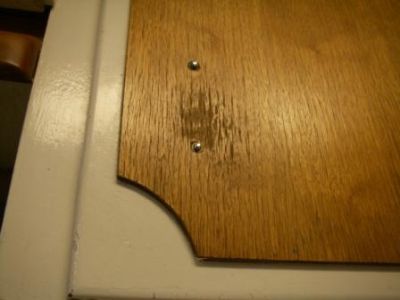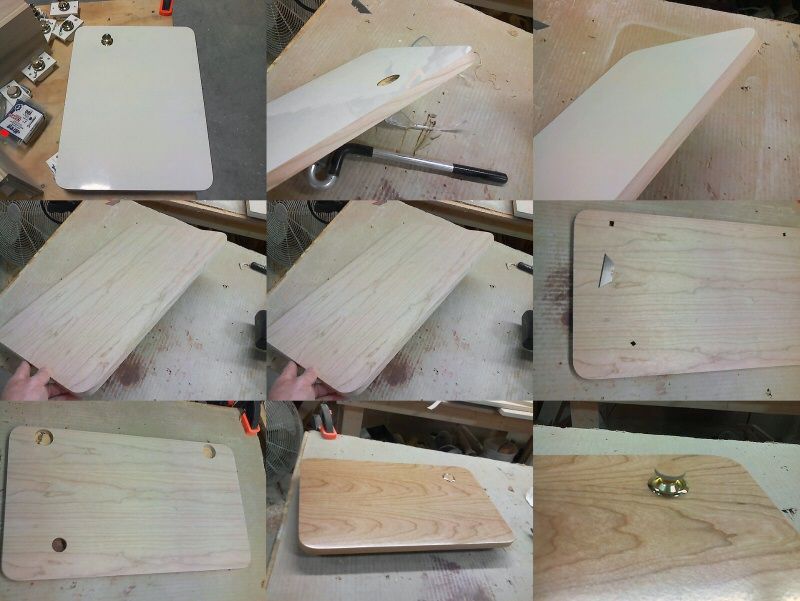Question
I got an email about refinishing some wood faces on cabinet doors. I've been doing some back and forth with the homeowner, trying to get a grasp on what he wants done. He sent me some photos of his kitchen, and I'm not certain if it's going to be possible, so I need some advice.
He wants the wood faces sanded down and recoated, mainly due to the damage around the handles. If I was sure that the faces of these doors were solid wood veneer, I wouldn't have an issue - I would just sand off the old finish, stain to match current colour, and re-clear. But I can't tell if this is just a laminate over an MDF slab. If it is, what should I tell him? Do you think something like this is repairable with some paste wood filling and a touchup marker (if it's a laminate?)

Forum Responses
(Finishing Forum)
From contributor R:
A good close look at the edge of the door should tell you all you need to know. Almost certain they are veneer. They didn't get enough finish on them originally and wore through from contact at the pulls. It then looks like they got wet somehow and discolored the wood. To fix this properly, they should either be stripped and sanded and refinished or replaced with a new set of doors.
I told him I could sand down the finish and touch up around the handles, followed by topcoats - though I'm not sure that would blend well enough... Hence the paste wood fill and touchup marker idea. I too think it's a thin veneer, so sanding down to raw wood may be out of the question. I considered stripping, as it's just flat panels, but I'm worried it will damage the wood, as it may be too thin. There doesn't seem to be much finish on those doors at all, so a chemical stripper may be too much for them. Also I don't want to damage the white paint because he doesn't want that part done, just the wood.
The first solution would only take a few minutes, and right away you would know to go on to the next step. With the sanding step, as long as you are careful and really have a feel for the sander, i.e. you know when you are about to go too far, you won't have sanded below the veneer, and it is still reasonably fast. The last step is to strip. I would do this before I re-laminated them or bought new panels. I do a whole lot of chemical stripping. Just recently I was doing work on an old federal courthouse that is no longer in use as a courthouse, but was bought to use as an office building. It is on the national historic registry, so replacing was not allowed. You can strip effectively and quickly as long as you know what steps to take.
If you do strip them on site and do not want to damage the white, use Zipstrip or a comparable high strength semi-paste stripper. You want a good semi-paste because you will need to control it around the edges so as not to damage the white. Following the stripping, after you have successfully removed the finish, you will need to chemical wash them with a mixture of 1 part lacquer thinner (dissolves any remaining finish), 1 part denatured alcohol (dissolves the wax that will be in most strippers), and 1 part mineral spirits (isn't as hot and doesn't evaporate as fast as the other two, is used because as the other two chemicals break down substances, the mineral spirits stay wet long enough to clean them off with a rag). You do not want to mix a lot at any time. Just mix small amounts at a time, and keep using clean chemicals. You do this to avoid re-contaminating the finish.
If all this fails, you tried your best to save his doors. You now can reface them.
1) What is causing the darkening? It is difficult to touch up to a lighter color. Maybe it can be done satisfactorily with 1 or 2 doors, but with more, there will be a lot of variation in the results.
2) Sanding can easily result in a sand-through of the (supposed) veneer, or if not sanded sufficiently to remove the current finish, it will result in uneven staining.
3) Trying to selectively strip only the panels could easily lead to a few "oops" on the painted sections, requiring additional labor to solve that problem.
4) With these particular doors, stripping the entire door has an added expense of having to work with the panel separately from the rest of the door in the staining, painting, and refinishing, thus adding significantly to labor. Offsetting this is the fact that each step of the process can be handled en masse, assuming you have a flow-over or stripping vat.
If it were me facing this task (and I have a substantial range of methods to use), given the budget constraints of the customer, I think I would use the peel-and-stick veneer suggested, to maintain the same look. But it can be tedious to trim the veneer. Stain and finish by hand. Or mask off and spray.
Even cheaper - just paint the panels brown (although it hurts down to my soul to suggest this). Make sure the customer is aware that this approach is a repair, not a renovation or restoration. And make sure that the customer understands that you are not a non-profit institution.

If all else fails and I must reface them, how difficult is veneering? I have never done any veneer work, though since it has been mentioned here, I started doing some homework. I'm not much of a woodworker, but when presented an opportunity to learn something new I'll never back down! How much is that peel 'n' stick veneer? Where would I find it? I came across a few threads mentioning a curling issue after the finish has been applied. Is this a common problem?
The good thing is the doors already fit. The cost of the plywood may be cheaper, but the extra work to make the doors may offset that cost savings pretty quick. Both options are viable. If you can't get the P&S easily, then the plywood route may be easier.